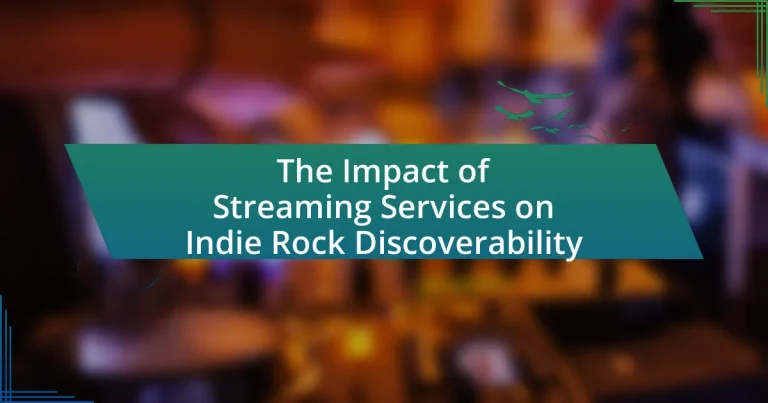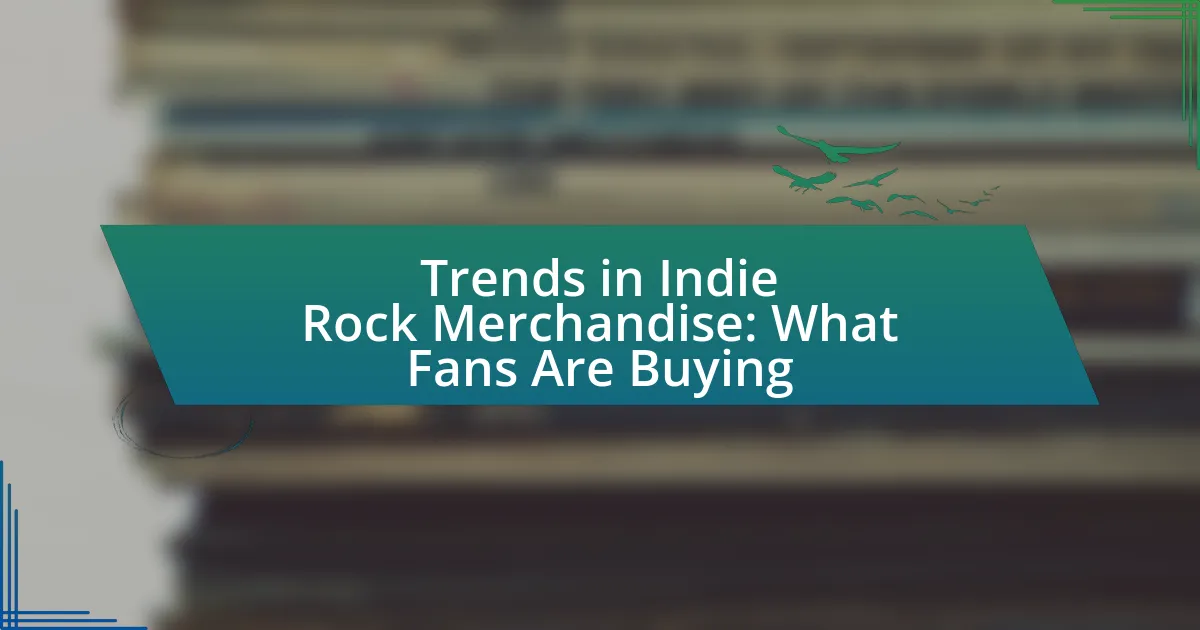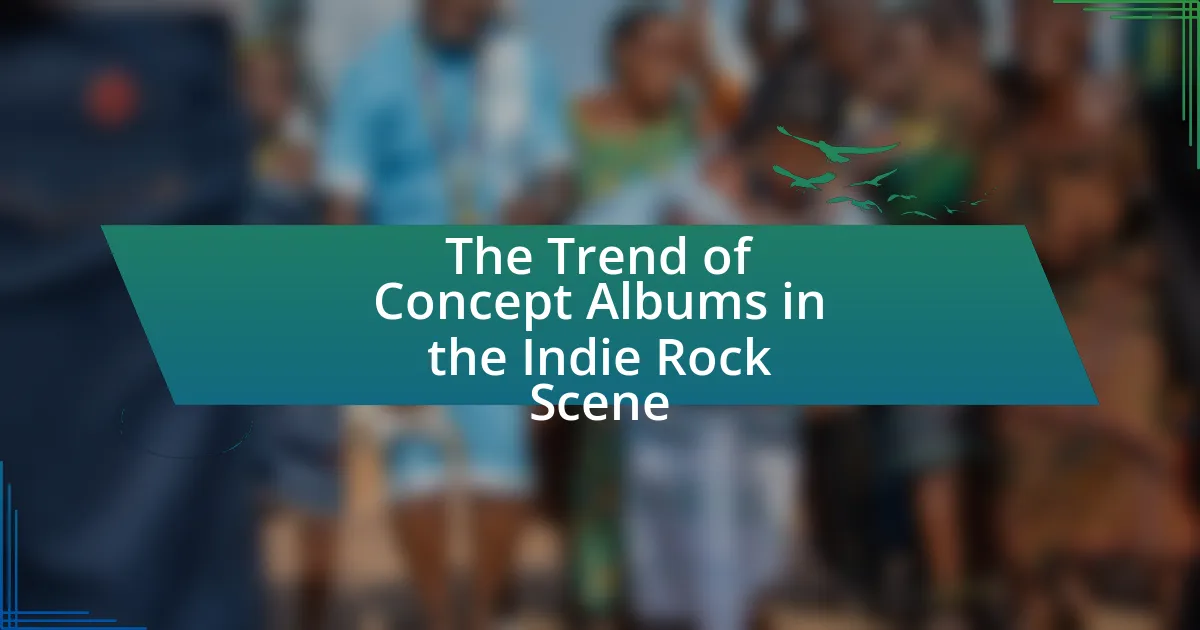The article examines the impact of streaming services on the discoverability of indie rock artists, highlighting how platforms like Spotify and Apple Music enhance exposure through algorithms and curated playlists. It discusses the transformation of the music landscape, allowing indie musicians to reach global audiences without traditional label support, while also addressing the challenges posed by market oversaturation and algorithmic bias. Key features such as user-generated playlists and social media integration are explored, along with strategies for artists to improve their visibility and engagement. The article emphasizes the importance of discoverability in shaping an artist’s career trajectory and financial success in the competitive music industry.
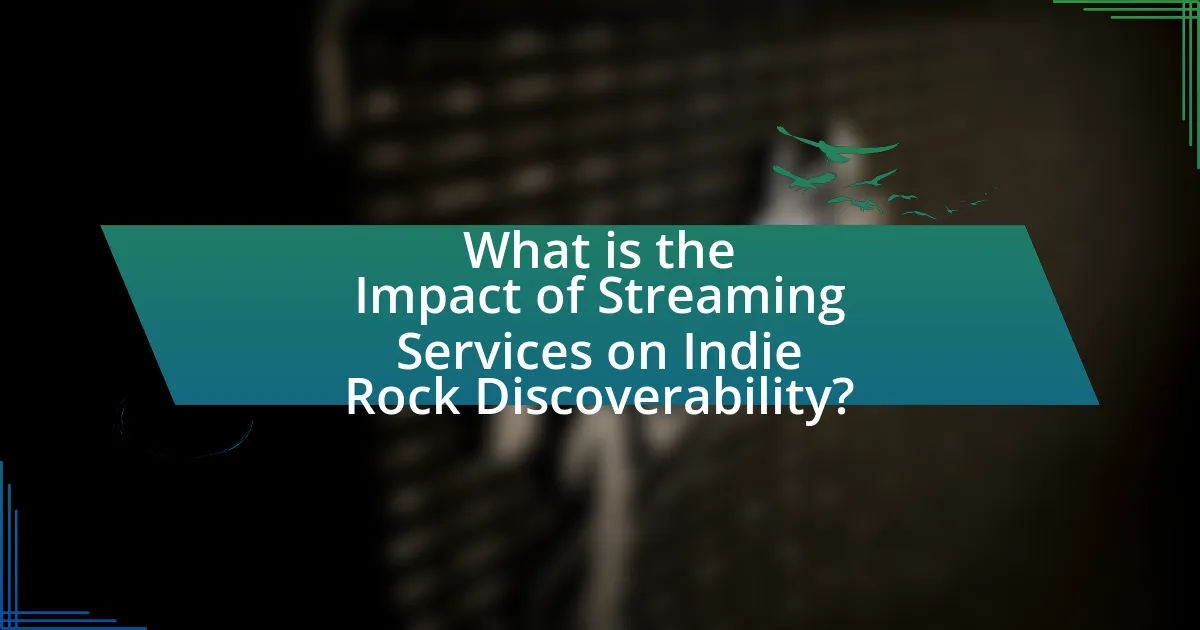
What is the Impact of Streaming Services on Indie Rock Discoverability?
Streaming services significantly enhance the discoverability of indie rock artists by providing a platform that reaches a global audience. These platforms, such as Spotify and Apple Music, utilize algorithms that promote lesser-known artists alongside popular tracks, increasing exposure for indie rock musicians. For instance, Spotify’s curated playlists often feature indie rock songs, which can lead to millions of streams and new fan bases. According to a 2021 report by the International Federation of the Phonographic Industry, 70% of music listeners discover new artists through streaming services, highlighting their crucial role in artist visibility.
How have streaming services changed the landscape for indie rock artists?
Streaming services have significantly transformed the landscape for indie rock artists by providing unprecedented access to global audiences. These platforms, such as Spotify and Apple Music, allow indie rock musicians to distribute their music widely without the need for traditional record label support, which historically limited exposure. According to a 2021 report by the International Federation of the Phonographic Industry, streaming accounted for 62% of global recorded music revenue, highlighting its dominance in music consumption. This shift enables indie rock artists to reach listeners directly, build fan bases, and generate revenue through streaming royalties, which were previously challenging to achieve in a market dominated by major labels.
What role do algorithms play in promoting indie rock music?
Algorithms play a crucial role in promoting indie rock music by personalizing music recommendations and enhancing discoverability on streaming platforms. These algorithms analyze user data, such as listening habits and preferences, to curate playlists that feature indie rock artists, thereby increasing their exposure to potential listeners. For instance, Spotify’s algorithm uses machine learning to suggest tracks based on user interactions, which has led to a significant rise in streams for indie rock bands. According to a 2021 report by the International Federation of the Phonographic Industry, over 60% of music listeners discover new artists through algorithm-driven playlists, highlighting the effectiveness of these systems in promoting indie rock music.
How do playlists influence the visibility of indie rock bands?
Playlists significantly enhance the visibility of indie rock bands by curating their music for broader audiences. When indie rock tracks are featured on popular playlists, they gain exposure to listeners who may not have discovered the bands otherwise. For instance, Spotify’s editorial playlists, which have millions of followers, can lead to substantial increases in streaming numbers and fan engagement. Data shows that tracks included in playlists can experience a 30% to 50% increase in streams shortly after being added, demonstrating the direct impact of playlist placements on discoverability.
Why is discoverability important for indie rock artists?
Discoverability is crucial for indie rock artists because it directly influences their ability to reach new audiences and gain traction in a competitive music landscape. With the rise of streaming services, indie rock artists face the challenge of standing out among millions of tracks; thus, effective discoverability strategies can significantly enhance their visibility. According to a 2021 report by the International Federation of the Phonographic Industry, 70% of music listeners discover new music through streaming platforms, highlighting the importance of being featured in playlists and recommendations. This increased exposure can lead to higher streaming numbers, more concert attendance, and ultimately, greater financial success for indie rock artists.
What challenges do indie rock artists face in gaining exposure?
Indie rock artists face significant challenges in gaining exposure primarily due to the oversaturation of the music market and the algorithms used by streaming services. The music industry has seen a dramatic increase in the number of artists, with over 60,000 new tracks uploaded daily to platforms like Spotify, making it difficult for indie artists to stand out. Additionally, streaming algorithms often favor established artists, limiting the visibility of emerging talent. This creates a barrier for indie rock artists who rely on these platforms for discoverability, as they struggle to gain traction in a competitive landscape dominated by major labels and popular acts.
How does discoverability affect an artist’s career trajectory?
Discoverability significantly influences an artist’s career trajectory by determining their visibility and access to potential audiences. When artists are easily discoverable on streaming platforms, they have a higher chance of gaining listeners, which can lead to increased streaming numbers, fan engagement, and opportunities for live performances. For instance, a study by Nielsen Music found that 75% of listeners discover new music through streaming services, highlighting the critical role these platforms play in an artist’s exposure. Consequently, enhanced discoverability can lead to greater commercial success and longevity in an artist’s career.
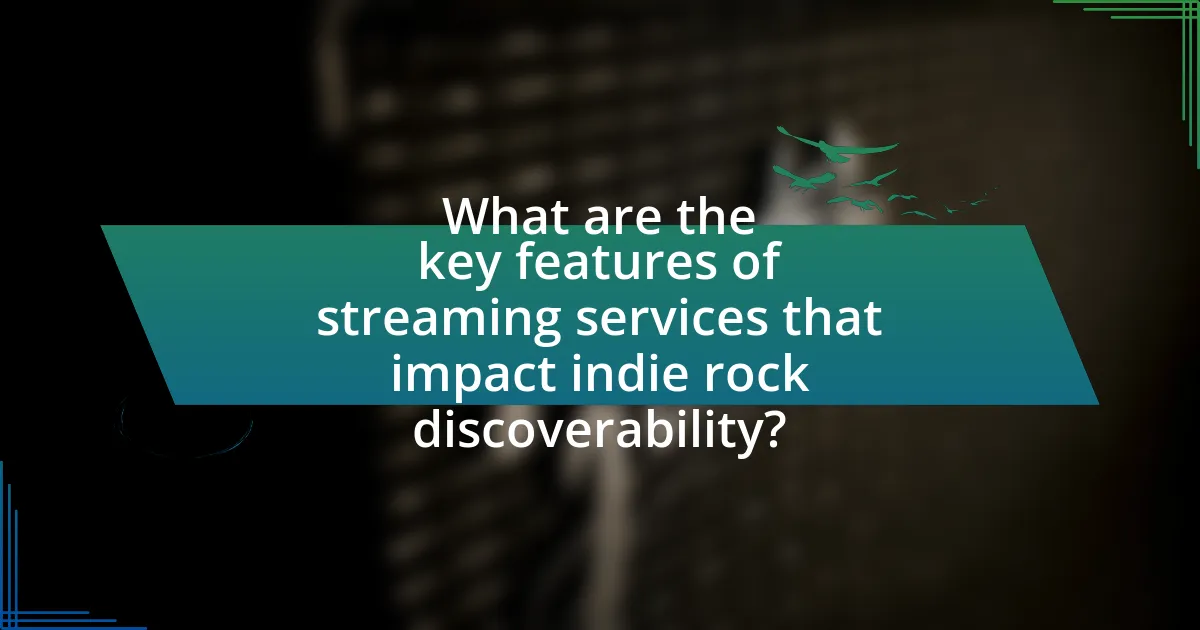
What are the key features of streaming services that impact indie rock discoverability?
The key features of streaming services that impact indie rock discoverability include algorithmic recommendations, curated playlists, user-generated content, and social sharing capabilities. Algorithmic recommendations utilize user listening habits to suggest indie rock tracks, significantly increasing exposure; for instance, Spotify’s Discover Weekly playlist has been credited with boosting streams for lesser-known artists. Curated playlists, often created by music editors or influencers, highlight indie rock songs, providing a platform for new artists to reach wider audiences. User-generated content, such as reviews and shares, enhances visibility and engagement, as seen on platforms like SoundCloud, where community interaction can propel indie tracks into mainstream awareness. Lastly, social sharing features allow users to easily share their favorite indie rock songs across social media, further amplifying discoverability through personal networks.
How do user-generated playlists contribute to indie rock discoverability?
User-generated playlists significantly enhance indie rock discoverability by curating diverse selections that expose listeners to lesser-known artists. These playlists often reflect personal tastes and niche genres, allowing indie rock musicians to reach audiences who may not encounter their music through mainstream channels. According to a study by the Music Industry Research Association, playlists created by users account for over 30% of music discovery on streaming platforms, demonstrating their crucial role in promoting indie rock. This organic sharing fosters community engagement and encourages listeners to explore new sounds, ultimately increasing the visibility and reach of indie rock artists.
What strategies can artists use to get featured on popular playlists?
Artists can increase their chances of being featured on popular playlists by actively engaging with playlist curators and utilizing social media for promotion. Building relationships with curators through personalized outreach, such as sending tailored emails or messages, can lead to better visibility. Additionally, artists should leverage platforms like SubmitHub, which connects musicians with curators, allowing for targeted submissions.
Data from a 2021 study by the Music Industry Research Association indicates that artists who engage with curators see a 30% higher chance of playlist inclusion compared to those who do not. Furthermore, maintaining a strong social media presence can attract attention from curators, as they often look for artists with an engaged fan base. By combining these strategies, artists can effectively enhance their discoverability on streaming platforms.
How do collaborative playlists enhance exposure for indie rock artists?
Collaborative playlists enhance exposure for indie rock artists by allowing multiple users to contribute and share music, thereby increasing the reach and visibility of lesser-known tracks. These playlists often aggregate diverse musical tastes, attracting listeners who may not typically explore indie rock, thus broadening the audience base. According to a study by the International Federation of the Phonographic Industry, playlists are a significant driver of music discovery, with 31% of listeners discovering new music through curated playlists. This mechanism enables indie rock artists to gain traction in a competitive market, as their songs can be featured alongside more popular tracks, facilitating organic growth in listener engagement and streaming numbers.
What metrics do streaming services use to measure success for indie rock artists?
Streaming services measure success for indie rock artists primarily through metrics such as stream counts, listener engagement, playlist placements, and social media interactions. Stream counts indicate the total number of times a song has been played, reflecting its popularity. Listener engagement metrics, including average listen duration and repeat listens, provide insight into how well the audience connects with the music. Playlist placements on popular curated lists can significantly boost visibility and reach, while social media interactions, such as shares and comments, demonstrate audience interest and community building. These metrics collectively help streaming platforms assess the impact and reach of indie rock artists in the digital music landscape.
How do streaming numbers correlate with an artist’s popularity?
Streaming numbers directly correlate with an artist’s popularity, as higher streaming counts typically indicate greater listener engagement and broader audience reach. For instance, artists with millions of streams on platforms like Spotify often achieve higher visibility in playlists and recommendations, which can lead to increased ticket sales and merchandise revenue. A study by the International Federation of the Phonographic Industry (IFPI) in 2021 revealed that 70% of music listeners discover new artists through streaming services, highlighting the significant role these platforms play in shaping an artist’s public profile. Additionally, Billboard charts often reflect streaming data, further solidifying the connection between streaming performance and overall popularity in the music industry.
What insights can artists gain from streaming analytics?
Artists can gain valuable insights from streaming analytics, including listener demographics, engagement metrics, and geographic data. These analytics reveal who is listening to their music, how often tracks are played, and where their audience is located. For instance, understanding listener demographics allows artists to tailor marketing strategies and target specific age groups or genders effectively. Engagement metrics, such as skip rates and playlist additions, indicate which songs resonate most with audiences, guiding future music production. Geographic data helps artists identify potential markets for live performances and promotional efforts, enhancing their overall reach and discoverability in the indie rock scene.
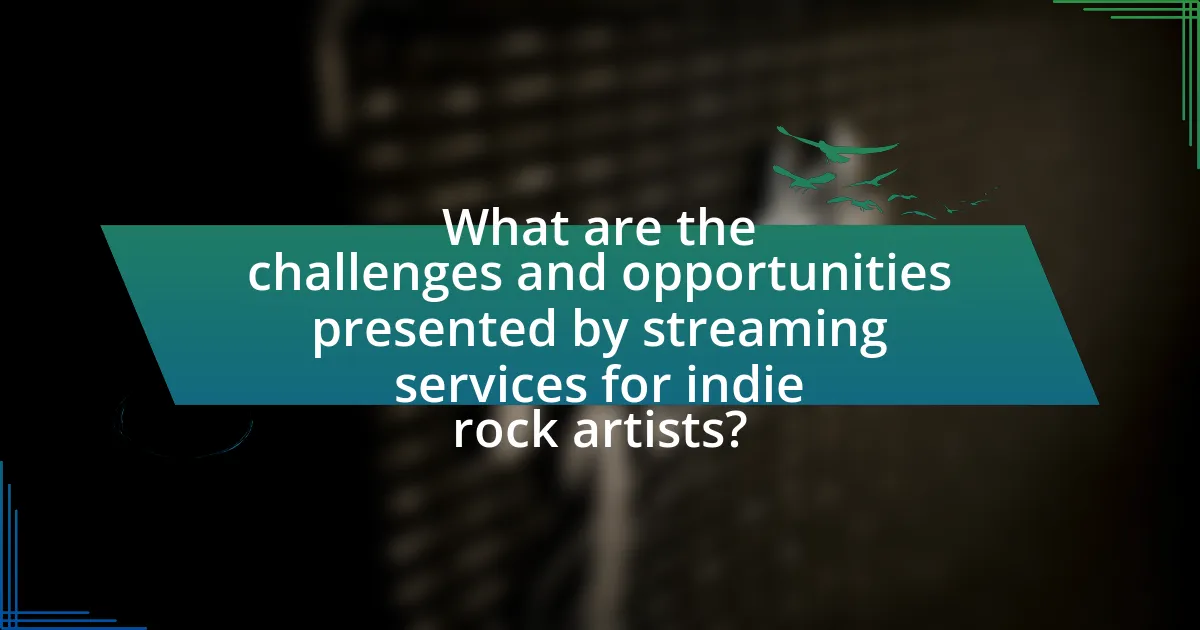
What are the challenges and opportunities presented by streaming services for indie rock artists?
Streaming services present both challenges and opportunities for indie rock artists. The primary challenge is the oversaturation of content, making it difficult for indie artists to stand out among millions of tracks, which can dilute their visibility and potential listener engagement. Additionally, the revenue model of streaming services often results in lower payouts per stream, which can hinder financial sustainability for indie artists who rely on music sales for income.
Conversely, streaming services offer significant opportunities for indie rock artists by providing a global platform for exposure without the need for traditional record label support. Artists can reach a wider audience through curated playlists and algorithm-driven recommendations, which can lead to increased fan engagement and concert attendance. According to a 2021 report by the International Federation of the Phonographic Industry, streaming accounted for 62% of global recorded music revenue, highlighting the potential for indie artists to monetize their music through these platforms.
What are the potential downsides of relying on streaming services for discoverability?
Relying on streaming services for discoverability can lead to oversaturation and algorithmic bias. Oversaturation occurs as countless indie rock artists compete for attention on the same platforms, making it difficult for individual musicians to stand out. According to a 2021 report by the International Federation of the Phonographic Industry, over 60,000 new tracks are uploaded to Spotify daily, which contributes to a crowded marketplace where many artists struggle to gain visibility. Algorithmic bias further complicates discoverability, as streaming services often prioritize popular or trending content, limiting exposure for emerging artists. A study by the University of Southern California found that algorithms can reinforce existing popularity, creating a cycle where only a small percentage of artists receive significant attention, thereby marginalizing indie rock musicians who may not fit mainstream trends.
How can artists mitigate the risks associated with streaming platforms?
Artists can mitigate the risks associated with streaming platforms by diversifying their revenue streams and actively engaging with their audience. Diversification can include selling merchandise, offering exclusive content through subscription services, and performing live shows, which collectively reduce reliance on streaming royalties. Engaging with their audience through social media and direct communication fosters a loyal fan base, which can lead to increased support during live events and merchandise sales. According to a 2021 report by the Music Industry Research Association, artists who actively engage with their fans see a 30% increase in merchandise sales, demonstrating the effectiveness of these strategies in enhancing financial stability amidst the uncertainties of streaming platforms.
What alternative strategies can indie rock artists pursue for discoverability?
Indie rock artists can pursue alternative strategies for discoverability by leveraging social media platforms, engaging in live streaming performances, and collaborating with other artists. Social media platforms like Instagram and TikTok allow artists to reach wider audiences through targeted content and viral trends, with TikTok alone generating over 1 billion monthly active users, providing significant exposure opportunities. Live streaming performances on platforms such as Twitch or YouTube can create direct engagement with fans, allowing artists to showcase their music in real-time and build a loyal following. Collaborating with other artists can also enhance visibility, as partnerships often introduce each artist’s fan base to the other’s work, effectively expanding reach. These strategies are increasingly vital in a landscape dominated by streaming services, where competition for attention is fierce.
How can indie rock artists effectively leverage streaming services for their benefit?
Indie rock artists can effectively leverage streaming services by utilizing playlist placements, engaging with their audience through social media, and analyzing streaming data to refine their marketing strategies. Playlist placements on platforms like Spotify and Apple Music can significantly increase visibility, as curated playlists often reach millions of listeners; for instance, Spotify’s “Discover Weekly” has been known to boost streams for featured artists by up to 30%. Engaging with fans on social media platforms helps build a loyal following, which can translate into increased streams and shares. Additionally, analyzing streaming data allows artists to understand listener demographics and preferences, enabling them to tailor their promotional efforts effectively. This data-driven approach has been shown to enhance audience targeting and improve overall engagement.
What best practices should artists follow to maximize their reach on streaming platforms?
Artists should focus on consistent content release, effective social media promotion, and playlist placements to maximize their reach on streaming platforms. Regularly releasing new music keeps the audience engaged and increases visibility, as platforms often favor active artists in their algorithms. Utilizing social media to connect with fans and promote releases can drive traffic to streaming profiles, enhancing discoverability. Additionally, securing placements on popular playlists can significantly boost streams; for instance, being featured on a major playlist can lead to a substantial increase in monthly listeners, as evidenced by data showing that tracks on curated playlists receive up to 10 times more streams than those not featured.
How can social media integration enhance streaming success for indie rock artists?
Social media integration can significantly enhance streaming success for indie rock artists by providing a platform for direct engagement with fans and promoting their music. By leveraging social media channels, indie rock artists can share their streaming links, announce new releases, and interact with their audience, which fosters a loyal fanbase. According to a 2021 study by the International Music Summit, 70% of music listeners discover new artists through social media platforms, highlighting the importance of these channels in driving streaming traffic. Additionally, social media allows for targeted advertising, enabling artists to reach specific demographics that align with their music style, further increasing their streaming numbers.
What practical tips can indie rock artists implement to improve their discoverability on streaming services?
Indie rock artists can improve their discoverability on streaming services by optimizing their profiles, engaging with listeners on social media, and utilizing playlists effectively. Optimizing profiles includes ensuring high-quality images, complete bios, and links to social media, which can enhance visibility. Engaging with listeners through platforms like Instagram and Twitter fosters a community and encourages sharing of music. Additionally, submitting tracks to curated playlists can significantly increase exposure; according to a study by Spotify, tracks featured on playlists can see a 30% increase in streams. These strategies collectively enhance the chances of being discovered by new audiences.
